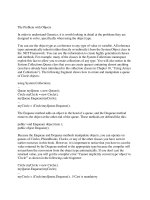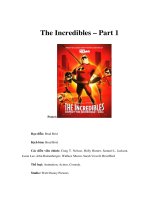Tài liệu The Criminal Law Handbook Know Your Rights, Survive the System 9th edition doc
Bạn đang xem bản rút gọn của tài liệu. Xem và tải ngay bản đầy đủ của tài liệu tại đây (2.44 MB, 630 trang )
9th edition
The Criminal
Law Handbook
Know Your Rights, Survive the System
by Attorneys Paul Bergman
& Sara J. Berman-Barrett
Nolo’s Legal Updater
We’ll send you an email whenever a new edition of this book is
published! Sign up at
www.nolo.com/legalupdater.
Updates @ Nolo.com
Check
www.nolo.com/update to nd recent changes
in the law that affect the current edition of your book.
Nolo Customer Service
To make sure that this edition of the book is the most
recent one, call us at 800-728-3555 and ask one of
our friendly customer service representatives.
Or nd out at
www.nolo.com.
The law changes, but Nolo is on top of it! We offer several
ways to make sure you and your Nolo products are up to date:
always up to date
2
1
3
We believe accurate, plain-English legal information should help
you solve many of your own legal problems. But this text is not a
substitute for personalized advice from a knowledgeable lawyer.
If you want the help of a trained professional—and we’ll always
point out situations in which we think that’s a good idea—consult
an attorney licensed to practice in your state.
please note
9th edition
The Criminal
Law Handbook
Know Your Rights, Survive the System
by Attorneys Paul Bergman
& Sara J. Berman-Barrett
NINTH EDITION SEPTEMBER 2007
Editor RICHARD STIM
Cover design SUSAN PUTNEY
Production SARAH HINMAN
Proofreading CHRISTINE SINNOTT
Index BAYSIDE INDEXING SERVICE
Printing DELTA PRINTING SOLUTIONS, INC.
Bergman, Paul, 1943-
The criminal law handbook : know your rights, survive the system / by Paul
Bergman & Sara J. Berman-Barrett 9th ed.
p. cm.
Includes bibliographical references and index.
ISBN-13 978-1-4133-0704-7 (pbk.)
ISBN-10 1-4133-0704-3 (pbk.)
1. Criminal procedure United States Popular works. I. Berman-Barrett, Sara
J., 1964- II. Title.
KF9619.6.B47 2007
345.73'05 dc22
2007013009
Copyright © 1997, 2000, 2002, 2003, 2004, 2005, 2006, and 2007 by Paul Bergman
and Sara J. Berman-Barrett
ALL RIGHTS RESERVED. PRINTED IN THE U.S.A.
No part of this publication may be reproduced, stored in a retrieval system, or
transmitted in any form or by any means, electronic, mechanical, photocopying,
recording, or otherwise without the prior written permission of the publisher and
the authors. Reproduction prohibitions do not apply to the forms contained in this
product when reproduced for personal use.
For information on bulk purchases or corporate premium sales, please contact the
Special Sales department. For academic sales or textbook adoptions, ask for
Academic Sales. Call 800-955-4775 or write to Nolo at 950 Parker Street, Berkeley,
CA, 94710.
Dedication
To Hilary, Julia and Daniel.
—PB, SBB
Acknowledgments
Our thanks:
To attorneys Jake Warner and Steve Elias of Nolo for first envisioning a book about the
criminal justice process.
To Janet Portman and Rich Stim for their hard work and dedication to the text.
To Dean Laurie Levenson, a former prosecutor and legal commentator; Michael Roman, an
experienced criminal defense attorney; and Ron Schlesman, a longtime probation officer,
each of whom was kind enough to read through the entire text; and law professors David
Sklansky, Peter Arenella, and David Dolinko of the UCLA School of Law and Michael
Graham of the Miami School of Law for their many insights, critiques, and immensely
helpful suggestions.
To public defender and Concord law professor John Ciroli for his many insights into criminal
defense practice.
To attorney Steve Harvey for his insightful comments about the nature of the U.S. criminal
justice system, and,
To the many resourceful employees of Nolo who put their heart and energy into producing
such warm and helpful books and making sure the public knows about them.
To another former public defender, David Barrett, for answers to legal questions, for lock-up
to courtroom reality checks, and for setting an example as one who truly pursued justice;
and
Much appreciation to Dr. LaVera Otoyo for sharing wisdom and stories gathered from her
many years of service to America’s juvenile justice system.
To the Martinez family, whose loving care enabled the long hours of research and writing.
Thanks to UCLA law student Caleb Bartels for his research and contributions to the
9th edition.
To UCLA School of Law professor Stuart Banner for his help with the death penalty section.
Table of Contents
Your Legal Companion
Introduction
A Walk-Through of the Case of State v. Andrea Davidson,
a Fictional Robbery Prosecution 4
1: Talking to the Police
Section I: Police Questioning of People Who Haven’t Been
Taken Into Custody 13
Section II: Police Questioning of Arrestees 20
2: Search and Seizure: When the Police Can Search
for and Seize Evidence
Section I: The Constitutional Background 37
Section II: Search Warrants 41
Section III: Consent Searches 46
Section IV: The Plain View Doctrine 51
Section V: Warrantless Searches That Are Incident to Arrest 53
Section VI: “Stop and Frisk” Searches 55
Section VII: Searches of Car and Occupants 58
Section VIII: Warrantless Searches or Entries
Under Emergency (Exigent) Circumstances 63
Section IX: Miscellaneous Warrantless Searches 64
3: Arrest: When It Happens, What It Means
Section I: General Arrest Principles 75
Section II: Arrest Warrants 79
Section III: Warrantless Arrests 80
Section IV: Use of Force When Making Arrests 83
Section V: Citizens’ Arrests 86
4: Eyewitness Identification: Psychology and Procedures
Section I: An Overview of Eyewitness Identification Procedures 93
Section II: The Psychology of Eyewitness Identification 96
Section III: Lineups 98
Section IV: Showups 103
Section V: Photo Identifications 104
Section VI: Motions to Suppress Identifications 105
5: Booking and Bail: Checking In and Checking Out of Jail
Section I: The Booking Process 111
Section II: Arranging for Bail 114
Section III: Own Recognizance Release (Release O.R.) 124
6: From Suspect to Defendant: How Crimes Get Charged
Section I: Crime and Criminal Cases 129
Section II: To Charge or Not to Charge, That Is the Question 131
Section III: The Mechanics of Charging 139
Section IV: Grand Juries 142
Section V: Diversion 144
7: Criminal Defense Lawyers: Who They Are,
What They Do, How to Find One
Section I: Do I Need a Lawyer? 151
Section II: Court-Appointed Attorneys 154
Section III: Private Defense Attorneys 160
Section IV: Self-Representation 170
8: Understanding the Attorney-Client Relationship
in a Criminal Case
Section I: Confidentiality 181
Section II: Client-Centered Decision-Making 185
Section III: Lawyer-Client Communication 191
Section IV: Representing Guilty Defendants 192
Section V: Competent Clients 194
9: A Walk Through Criminal Court
Section I: The Courthouse 199
Section II: The Courtroom 200
Section III: The Courtroom Players 203
Section IV: Courtroom Behavior 210
10: Arraignments
Section I: Timing of Arraignments 215
Section II: Self-Representation at Arraignment 223
11: Developing the Defense Strategy
Section I: Overview 229
Section II: How the Defendant’s Version of Events May Limit
Defense Strategies 233
Section III: When Attorneys Ignore a Defendant’s Version of Events 237
Section IV: The Importance of Honesty in Developing a Defense Strategy 238
12: Crimespeak: Understanding the Language of Criminal Laws
Section I: Mens Rea 244
Section II: The Meaning of Frequently-Used Legal Language 247
Section III: Derivative Criminal Responsibility 252
Section IV: Murder and Manslaughter 258
Section V: Rape 262
Section VI: Burglary 264
Section VII: Robbery 267
Section VIII: Theft 268
Section IX: Hate Crimes 271
Section X: The Patriot Act 273
Section XI: White Collar Crimes 276
13: Defensespeak: Common Defenses to Criminal Charges
Section I: Prosecutor’s Failure to Prove Guilt 285
Section II: “Partial” Defenses 289
Section III: Self-Defense 292
Section IV: Alibi 295
Section V: Insanity 296
Section VI: Intoxication (Under the Influence of Drugs or Alcohol) 300
Section VII: Entrapment 302
Section VIII: Jury Nullification 302
14: Discovery: Exchanging Information With the Prosecution
Section I: Modern Discovery Policy 306
Section II: Discovery of Helpful Information 307
Section III: Discovery of Harmful Information 309
Section IV: Reciprocal Discovery 312
15: Investigating the Facts
Section I: Interviewing Prosecution Witnesses 316
Section II: Finding and Interviewing Defense Witnesses 319
Section III: Other Investigation Tasks and Their Costs 319
16: Preliminary Hearings
Section I: What Preliminary Hearings Are and When They Are Held 324
Section II: Basic Rights During Preliminary Hearings 329
Section III: Common Defense and Prosecution Strategies at the
Preliminary Hearing 332
17: Fundamental Trial Rights of the Defense
Section I: The Defendant’s Right to Due Process of Law 337
Section II: The Prosecution’s Burden of Proof 340
Section III: The Defendant’s Right to Remain Silent 342
Section IV: The Defendant’s Right to Confront Witnesses 345
Section V: The Defendant’s (and the Media’s) Right to a Public Trial 348
Section VI: A Defendant’s Right to a Jury Trial 351
Section VII: A Defendant’s Right to Counsel 352
Section VIII: A Defendant’s Right to a Speedy Trial 355
Section IX: The Defendant’s Right Not to Be Placed in Double Jeopardy 357
18: Basic Evidence Rules in Criminal Trials
Section I: Overview 363
Section II: Rules Regulating the Content of Testimony 367
Section III: Rules Regulating the Manner of Testimony 379
Section IV: Scientific Evidence 382
Section V: Privileged (Confidential) Information 387
19: Motions and Their Role in Criminal Cases
Section I: The Basic Procedures 393
Section II: Common Pretrial Motions 396
Section III: Motions During Trial 400
Section IV: Motions After Trial 402
20: Plea Bargains: How Most Criminal Cases End
Section I: Plea Bargaining—The Basics 409
Section II: The Pros and Cons of Plea Bargains 410
Section III: The Plea Bargaining Process 414
Section IV: The Strategy of Negotiating Plea Bargains 419
21: The Trial Process
Section I: Summary of the Trial Process 428
Section II: Choosing a Judge or Jury Trial 429
Section III: Jury Voir Dire 431
Section IV: Motions in Limine 435
Section V: Opening Statements 436
Section VI: Prosecution’s Case-in-Chief 437
Section VII: Direct Examination of Witnesses 438
Section VIII: Cross-Examination 441
Section IX: Defense Motion to Dismiss 442
Section X: Defendant’s Case-in-Chief 442
Section XI: Closing Argument 444
Section XII: Instructing the Jury 446
Section XIII: Jury Deliberations and Verdict 448
22: Sentencing: How the Court Punishes Convicted Defendants
Section I: Overview of Sentencing 456
Section II: Sentencing Procedures 463
Section III: Sentence Options 469
Section IV: The Death Penalty 481
References 487
23: Appeals: Seeking Review by a Higher Court
Section I: Appeals 490
Section II: Writs 496
24: How the Criminal Justice System Works: A Walk Through
Two Drunk Driving Cases
Section I: Questions and Answers About DUI (Driving Under the Influence) 502
Section II: DUI Case Examples 511
25: Juvenile Courts and Procedures
Section I: A Brief History of U.S. Juvenile Courts 521
Section II: Juvenile Court Jurisdiction 522
Section III: Deciding Whether to File Charges 525
Section IV: The Right to Counsel and Other Constitutional Rights 527
Section V: Trying Juveniles as Adults 532
Section VI: Sentencing (Disposition) Options 535
Section VII: Sealing Juvenile Court Records 540
26: Prisoners’ Rights
Section I: Prisons and Prisoners’ Rights 545
Section II: Legal Resources for Prisoners and Their Families 555
Section III: Parole 559
Section IV: Pardons 561
27: Looking Up the Law
Section I: What to Research 566
Section II: Where to Do Research 578
Section III: Glossary 579
Index
Your Legal Companion
W
hen can a police officer make an
arrest? Is it a good idea to talk to the
police? Who decides whether to charge
someone with a crime, and what crime to
charge? Is self-representation ever a good
idea in criminal cases? Should defendants
conceal their guilt from their attorneys?
What factors might convince a judge to
release a jailed person on low bail—or
waive bail altogether? All of these questions
can be perplexing, particularly if you’re not
familiar with the criminal justice system.
You may be asking these questions
because you, a relative, or a friend have
been arrested and charged with a crime.
Or perhaps you’ve been the victim of one.
Maybe you’re a teacher, social worker,
or counselor who needs clear answers to
pressing questions so you can help others
understand how the criminal justice system
works. Or perhaps you’re just glued in front
of Court TV and you want to know a little
more about the real-life courtroom drama
onscreen.
This book is for all of you.
It is written in an easy-to-understand
question-and-answer format to explain the
criminal justice system, inside and outside
the courtroom.
• If you are facing criminal charges,
this book will help you know enough
about what’s going on to intelligently
participate in important decisions that
are likely to affect the outcome.
• If someone close to you faces criminal
charges, you’ll want to know what
is happening and how you can be
of help—for example, does it matter
whether you are there in the courtroom
when your friend or relative is arraigned?
• If you are a victim of a crime, you too
will want to understand how the process
works and where in the process you can
expect to have an effect on how the case
is prosecuted.
Whatever prompts your interest, the
criminal justice system belongs to you. You
have a right to know how it works. The
information in this book tells you what you
never learned in high school civics.
2 CRIMINAL LAW HANDBOOK: KNOW YOUR RIGHTS, SURVIVE THE SYSTEM
Our book is in no way intended as a
detailed guide to self-representation. While
the information in the book will no doubt
assist those defendants who choose self-
representation, the authors assume that
those facing criminal charges for which jail
or prison is a possibility are represented
by an attorney, either privately retained or
appointed at government expense. The book
is, however, designed to empower criminal
defendants by helping them understand
every phase of the criminal justice process
and what types of defenses and strategies are
available to them.
Throughout the book, we have included
examples that illustrate specific questions,
sample dialogues of court proceedings,
and specific tips for the reader. Sample
documents commonly used in the criminal
justice process are located at the end of the
chapter in which they are discussed. The
examples are provided as illustrations only.
They are not designed to predict exactly
what will happen in a particular case.
This book describes the criminal justice
system as it tends to operate throughout the
country. But each state, as well as the federal
government, has its own set of criminal laws
and procedures. Thus, if you need to know
the terms of a specific law, or the procedures
your local court will follow, you will need
to consult the rules for your jurisdiction.
Chapter 27 explains how to find such rules
and other important information in a law
library and on the Internet.
You may need to consult more than one
chapter to get answers to your question. For
example, if you want to know when police
can search your home, you will find answers
in Chapters 2, Search and Seizure, and
Chapter 3, Arrest.
We encourage readers to use the
registration card at the back of the book to
pose questions of general concern. We’ll
incorporate the answers to these questions in
future editions. n
Introduction
A Walk-Through of the Case of State v. Andrea Davidson,
a Fictional Robbery Prosecution 4
4 CRIMINAL LAW HANDBOOK: KNOW YOUR RIGHTS, SURVIVE THE SYSTEM
A Walk-Through of the Case
of State v. Andrea Davidson, a
Fictional Robbery Prosecution
T
his walk-through is intended to quickly
familiarize you with what may happen
as a case wends its way through the criminal
justice system. While no two cases follow
the identical procedural path, the example
provides an overview of the entire process
and serves as a guide to where you’ll find
answers to the questions posed in the
walk-through, as well as loads of additional
important information.
1. Andrea Davidson is walking along
a public street when Officer Kevin Daniels
walks up to her and says, “Excuse me, I’d
like to ask you a few questions.”
reliable information connecting Andrea
to criminal activity before the officer can
question her?
officer’s questions? Is it a good idea
for her to talk to the officer even if she
doesn’t have to?
nothing wrong, does she have anything
to lose by talking to the officer?
See Chapter 1, Talking to the Police.
2. For many folks who are stopped and
questioned, lawfully or otherwise, contact
with the criminal justice system ends after
the police finish “on the street” questioning.
But as an example in our walk-through,
Andrea has a long road ahead of her.
Before questioning Andrea, Officer Daniels
proceeds to “frisk” her (pat down her outer
clothing).
and a search?
matter of routine?
seems to be a suspicious object, can the
officer remove it from Andrea’s clothing?
See Chapter 2, Search and Seizure:
When the Police Can Search for and Seize
Evidence.
3. Officer Daniels removes a gun from
Andrea’s coat, and arrests her for carrying a
concealed weapon.
suspect to jail?
before arresting Andrea?
See Chapter 3, Arrest: When It Happens,
What It Means.
4. Andrea is taken to jail by Officer
Daniels.
booked into jail?
bail out of jail?
cash bail and buying a bail bond?
See Chapter 5, Booking and Bail:
Checking In and Checking Out of Jail.
Introduction 5
5. Feeling very alone and scared, Andrea
considers contacting a lawyer.
What if she can’t afford to hire one?
does she have a right to do so? Is self-
representation generally a good idea?
jail?
lawyers and public defenders?
does the lawyer make all the decisions?
in jail, is their conversation confidential?
to have to provide Andrea with “due
process of law”?
See Chapter 7, Criminal Defense
Lawyers: Who They Are, What They Do,
How to Find One; Chapter 8, Understanding
the Attorney-Client Relationship in
a Criminal Case; and Chapter 17,
Fundamental Trial Rights of the Defense.
Multiple Coverage of
Some Subjects
As you read through the book, you may
notice that the same topic may arise in more
than one chapter. For example, we refer
to “motions in limine” in Chapters 19 and
21. We do this to reduce cross-referencing
and to help readers who want to read about
a particular part of the criminal justice
process before reading the book from
beginning to end.
6. Suspecting that Andrea was the culprit
who had robbed a convenience store a short
time before her arrest, Officer Daniels and
another police officer question Andrea about
her whereabouts at the time of the robbery.
police officers often read to suspects?
“Miranda” rights, does the case have to
be thrown out?
before they can warn her about her
“Miranda” rights, can what she says be
used against her in court?
See Chapter 1, Talking to the Police.
7. Officer Daniels asks Andrea to
participate in a lineup to determine
whether the store owner who was robbed
at gunpoint, Hilary Julia, is able to identify
Andrea as the robber.
lineup?
the police have shown the store owner a
picture of Andrea?
the right to have her lawyer attend the
lineup?
during the lineup?
See Chapter 4, Eyewitness Identification:
Psychology and Procedures, and Chapter 17,
Fundamental Trial Rights of the Defense.
6 CRIMINAL LAW HANDBOOK: KNOW YOUR RIGHTS, SURVIVE THE SYSTEM
8. Andrea’s answers to Officer Daniels’s
questions lead the officer to suspect that
evidence linking Andrea to the robbery is
inside her home (such as some of the loot
and a cap that the robber wore during the
robbery). Officer Daniels wants to get hold
of this evidence.
warrant before entering Andrea’s home?
house looking for evidence connecting
her to the robbery and finds illegal
drugs, can the officer seize the drugs
and charge Andrea with another crime?
illegally, does the case against her have
to be dismissed?
See Chapter 2, Search and Seizure:
When the Police Can Search for and Seize
Evidence.
9. Andrea is formally charged with
armed robbery.
about whether to charge Andrea with a
crime?
decide whether to charge Andrea with a
crime?
indictment from a grand jury?
prove to convict Andrea of armed
robbery?
See Chapter 6, From Suspect to
Defendant: How Crimes Get Charged, and
Chapter 12, Crimespeak: Understanding the
Language of Criminal Laws.
10. Andrea is taken to court and
“arraigned” on the armed robbery charge.
what should she do? Can she represent
herself?
release Andrea from jail?
See Chapter 9, A Walk Through Criminal
Court; and Chapter 10, Arraignments.
11. Andrea tells the arraignment judge
that she wants a lawyer but can’t afford to
hire one, so the judge appoints a lawyer to
represent her.
side of the story?
Andrea if she tells the attorney that she
committed the robbery?
defense attorney make before a case
goes to trial?
Andrea says confidential?
Andrea have the right to make?
See Chapter 8, Understanding the
Attorney-Client Relationship in a Criminal
Case; Chapter 11, Developing the Defense
Strategy; and Chapter 19, Motions and Their
Role in Criminal Cases.
12. Andrea’s lawyer talks to her about
the possibility of entering into a plea bargain.
pleading guilty?
Introduction 7
into a plea bargain?
pleading guilty?
that Andrea is offered?
bargaining process?
See Chapter 10, Arraignments, and
Chapter 20, Plea Bargains: How Most
Criminal Cases End.
13. Andrea pleads not guilty at the
arraignment, and decides that even though
she has a lawyer she should try to find out
more about the crime she’s charged with.
is a specific intent crime. What does
specific intent mean, and how will the
prosecutor try to prove it?
Andrea can raise at trial?
a library or on a computer, how can she
find information relevant to her case?
See Chapter 11, Developing the
Defense Strategy; Chapter 12, Crimespeak:
Understanding the Language of Criminal
Laws; Chapter 13, Defensespeak: Common
Defenses to Criminal Charges; and Chapter
27, Looking Up the Law.
14. At the conclusion of Andrea’s
arraignment, the judge schedules a date for a
preliminary hearing.
hearing?
to be present at the preliminary hearing?
the defense?
See Chapter 16, Preliminary Hearings.
15. At the conclusion of Andrea’s
preliminary hearing, the judge finds there
is probable cause to try her for robbery and
sets her case for trial. Andrea’s attorney tells
her, “I’ll continue gathering information in
preparation for trial.”
information over to the defense?
information to the prosecutor?
interview prosecution witnesses?
attorney investigate the case?
See Chapter 14, Discovery: Exchanging
Information With the Prosecution, and
Chapter 15, Investigating the Facts.
16. Though most cases end with
dismissals or guilty pleas before trial,
Andrea’s case does go to trial.
its evidence first?
offer evidence of her previous illegal
conduct?
testify?
or jury of her innocence?
8 CRIMINAL LAW HANDBOOK: KNOW YOUR RIGHTS, SURVIVE THE SYSTEM
See Chapter 17, Fundamental Trial
Rights of the Defense; Chapter 18, Basic
Evidence Rules in Criminal Trials; and
Chapter 21, The Trial Process.
17. Andrea is found guilty of armed
robbery and a date is set for sentencing.
than or in addition to going to jail?
sentence?
possible sentence?
uncovers for the first time an important
witness who supports her alibi defense,
what can she do?
See Chapter 19, Motions and Their
Role in Criminal Cases, and Chapter 22,
Sentencing: How the Court Punishes
Convicted Defendants.
18. Andrea believes that her conviction
was a mistake and wants to appeal it.
about what took place at Andrea’s trial?
Andrea’s argument that the jury
shouldn’t have believed the prosecutor’s
witnesses?
will the appellate court necessarily
overturn Andrea’s conviction?
See Chapter 23, Appeals: Seeking
Review by a Higher Court.
19. The conviction is overturned
because the judge mistakenly barred certain
evidence from the trial. Andrea is retried and
this time is found not guilty.
verdict to a higher court?
robbery charge in the future if new
evidence turns up?
order a new trial on the ground that the
jurors afterwards said that they thought
that Andrea was guilty but that she
didn’t deserve punishment?
See Chapter 13, Defensespeak:
Common Defenses to Criminal Charges;
Chapter 17, Fundamental Trial Rights of the
Defense; and Chapter 19, Motions and Their
Role in Criminal Cases.
20. Andrea’s conviction and five-year
prison sentence are upheld on appeal, so
Andrea has to serve time in state prison.
prison conditions?
custody of her child?
or after she is released?
prison?
released early on parole?
See Chapter 26, Prisoners’ Rights.
Introduction 9
Comparison of Federal and State Systems
The vast majority of criminal prosecutions take
place in state courts. The list below highlights
some of the key differences between state and
federal criminal systems.
Jurisdiction (“power” to decide cases)
A state has power over defendants who
violate the laws of that state. The federal
government has power over defendants who
commit criminal acts on federal property
(for example, an assault in a national park)
or whose criminal acts cross state lines (for
example, a kidnapper who transports a
victim from Iowa to Missouri). The federal
government also has jurisdiction over a group
of federally-defined crimes such as offenses
related to immigration fraud and U.S.
customs violations. A state and the federal
government can have “concurrent” power
over a defendant when the same criminal
activity violates both state and federal
laws (for example, selling drugs or robbing
banks). In those situations, state and federal
prosecutors make case-by-case decisions as
to whether a defendant will be prosecuted in
state or federal court.
Police Officers. Typical state police officers
are county sheriffs and city police officers.
Typical federal police officers are agents
of the FBI and DEA (Drug Enforcement
Administration).
Prosecutors. Federal criminal prosecutions
are handled by U.S. attorneys, who are
appointed by and are ultimately responsible
to the U.S. Attorney General. State
prosecutors, many of whom are elected on
a countywide basis, carry a variety of titles;
common ones are district attorney, state’s
attorney, and city attorney.
Defense Attorneys. Most criminal defendants
qualify for government-paid defense
attorneys. Government-paid attorneys
are usually employed either by an office
of the Federal Public Defender or a
county’s Public Defender office. (For
information about the differences between
government-paid and privately-retained
defense attorneys, see Chapter 7.)
Trial Courts. Most federal criminal
prosecutions occur in United States
District Courts. State courts carry such
titles as “superior court,” “municipal
court,” “police court,” or “county
court,” depending on the state and the
seriousness of criminal charges.
Judges. Federal trial judges are known as
District Court judges; they are appointed
for life by the president, subject to
confirmation by the U.S. Senate. State
court judges are typically initially
appointed by governors and then are
subject to election every few years. State
court trial judges carry such titles as
Superior Court Judge, Municipal Court
Judge, and (in New York) Supreme Court
Judge. In both state and federal courts,
magistrates may preside over pretrial
hearings such as bail hearings, as well as
less serious criminal trials.
All-Purpose vs. Specialized Judges.
Federal courts use the “all-purpose
judge” system. This means that the same
judge almost always presides over a
case from beginning to end—that is,
from a defendant’s first court appearance
to final acquittal or sentencing. Some
states also follow the all-purpose judge
model. In many states, however, judges
are specialized. For example, one judge
may determine bail (see Chapter 5),
another judge may hear pretrial motions
(see Chapter 19), and a third judge may
preside over a trial (see Chapter 21).
n
Chapter 1
Talking to the Police
Section I: Police Questioning of People Who Haven’t Been Taken Into Custody 13
1. Can a police officer stop me on the street and question me
even if I have done nothing wrong? 13
2. Is it a crime to refuse a police officer’s request for identification? 13
3. Can I walk away from a police officer who is questioning me? 14
4. If I start to answer a police officer’s questions, can I change my mind
and stop the interview? 15
5. A police officer told me that if I didn’t answer his questions
I’d be arrested for loitering. Is that legal? 15
6. An officer pulled me over for suspicion of drunk driving and questioned
me about where I’d been and what I’d had to drink. Can I be arrested for
refusing to answer these questions? 16
7. If I don’t have to answer questions, does this mean I can sue a police officer
for trying to question me? 16
8. Doesn’t a police officer always have to read me my “Miranda rights”
before questioning me? 17
9. A police officer wants to question me about a crime I know I didn’t
commit. Can I harm my own interests by talking? 17
10. Can it ever help me to answer a police officer’s questions? 19
11. A police officer wants to talk to me about a crime that I took part in.
Is it ever a good idea to try to talk my way out of it? 20
12. A police officer wants to ask me about a crime that a friend or relative
of mine committed. What do I risk by providing false information? 20
Section II: Police Questioning of Arrestees 20
13. What is a “Miranda warning”? 20
14. What happens if a suspect who is in custody isn’t given a Miranda warning
and answers a police officer’s questions? 22
15. Can the government ever use statements against defendants
if they were obtained in violation of Miranda? 22









